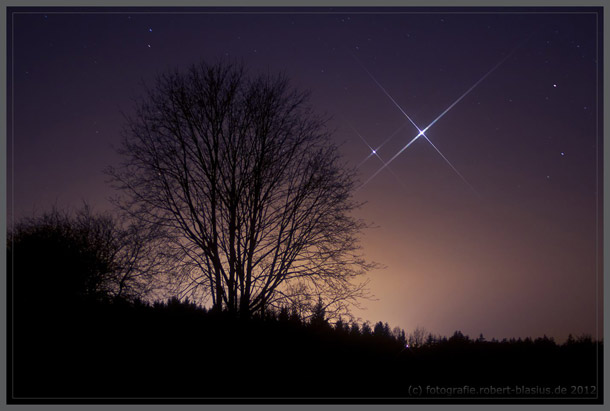Create a free profile to get unlimited access to exclusive videos, sweepstakes, and more!
Jupiter and Venus still blaze in the west

If you've been outside just after sunset and faced west, you've almost certainly seen two bright "stars" glaring back at you. Those aren't stars: they're Venus and Jupiter, the 3rd and 4th brightest natural objects in the sky (after the Sun and Moon, of course, and I say "natural" because the space station can in fact look brighter than both). As they circle the Sun, every year or so the orbital geometry of the two (and the Earth) sets things up such that they appear very close together in the sky. This is called a conjunction, and when it involves planets this bright, it's really something to see!
[Click to enaphroditenate.]
That stunning shot was taken by German astrophotographer Robert Blasius, and it's part of an incredible set of photos gathered by Astronomers Without Borders.
 Getting pictures of the two planets together is not hard; I rested my phone on a chair at a party in the middle of downtown Austin, Texas, and got a decent shot myself, shown here (click to embiggen). If you have a real camera, great pictures are a tripod and a click away.
Getting pictures of the two planets together is not hard; I rested my phone on a chair at a party in the middle of downtown Austin, Texas, and got a decent shot myself, shown here (click to embiggen). If you have a real camera, great pictures are a tripod and a click away.
The two will be close together for the next few days, too, so you have time.
I've been getting a lot of email and tweets about the pair, asking me about them. Venus is the brighter of the two planets, which is interesting: it's far smaller than Jupiter, and reflects less sunlight overall. So why is it so much brighter?
Because it's closer!
The brightness of a planet in our sky depends on a handful of things: how big it is, how reflective it is (an icy object is brighter than a rocky one), how far from the Sun it is, how far from us it is, and even our viewing angle. These can all be calculated, so what the heck. Let's do a little math!
Area of my expertise
The total light reflected by a planet depends on the surface area of that planet, which depends on the radius squared (remember your algebra? The area of a circle is Ï x (radius)2). Jupiter has a radius about 71,500 km, and the radius of Venus is about 6050 km.
Squaring those two and getting the ratio, we get
area of Venus / area of Jupiter = 0.0072
So all things being equal, Venus should only be 0.0072 times as bright as Jupiter, or, flipping it, Jupiter should be about 140 times brighter than Venus! But all things are not equal...
A planet's day in the Sun
Jupiter is farther from the Sun than Venus, and that means it gets less sunlight than Venus does. The amount of light an objects gets from the Sun depends on its distance from the Sun squared (this is called the inverse square law of light). We can figure that out too! Just divide the distance of Jupiter from the Sun by Venus's distance from the Sun, and square that:
Jupiter's current distance from the Sun is about 746 million km, and Venus is about 108 million km. So,
(746 million / 108 million)2 = 47.7
So Venus receives about 47.7 times as much sunlight as Jupiter does, and all things being equal should be 47.7 times as bright. But we're not done...
Long way home
The light from each planet also has to get from there to here, to Earth. Again, that goes as the square of the distance! So we have to account for that. Right now, Jupiter is about 846 million km from Earth, and Venus is about 121 million km distant. Let's square those and see what happens:
(846 million / 121 million)2 = 48.9
Yikes, another factor of almost 50! So again, due to their respective distances from the Earth, Venus should be 48.9 times brighter than Jupiter. But wait! There's more ...
Pause to reflect
Both Venus and Jupiter are highly reflective -- both are covered in clouds, though the clouds of Venus are somewhat more reflective than those of Jupiter. Venus has a reflectivity (called its albedo) of about 67%, and Jupiter is about 52%. That's pretty close. The ratio is
.67 / 0.5 = 1.29
So Venus wins there too.
And still there is one more thing: phase! We see Venus roughly "half full" right now because it's off to the side of the Sun, while Jupiter is "full". According to the US Naval Observatory, 57.6% of Venus is lit right now from our view. So we have to account for that by throwing a factor of 0.58 on Venus.
And now we're ready to put them all together!
So let's figure out how much brighter Venus is than Jupiter by putting these all together. All we have to do is multiply them all, making sure we do it in terms of Venus to be consistent:
Venus brightness / Jupiter brightness = 0.0072 x 47.7 x 48.9 x 1.29 x 0.58 = 12.6
So Venus should be a bit less than 13 times brighter than Jupiter according to my calculations.
Is that right? Looking up the actual numbers on Heavens Above, I get that Venus is actually about 8 times brighter than Jupiter. My number's off, but not by much. That's not bad, considering I just threw some numbers together based on straight geometry and did some very rough math.
I love this aspect of astronomy: using nothing more than a few first principles -- how light gets dimmer with distance, how objects reflect that light, and how we see them -- I was able to predict that Venus should be brighter than Jupiter, and even by how much! The actual amount may be off, but I wasn't wrong by a factor of ten, say. Just that basic knowledge got me pretty close, and no doubt there are a handful of other factors that, when accounted for, get this much closer if not bang on the right number.
After all, the Universe knows what it's doing. And science is a great way -- the best way -- to understand what the Universe is doing. Make a few assumptions, test them out, see how well they fit what's really going on, and then look more deeply into the problem. I'll hold off here from going deeper into the numbers above (though I'll bet I see some folks in the comments diving in), but this is a great example on how science zeroes in on a solution.
And honestly, you don't have to do all the math to go outside and take a look. Please do! The math isn't hard, but what's easier is facing west and looking up. That is the heart of astronomy.
Look up!
Image credit: Robert Blasius/Astronomers Without Borders; me



























